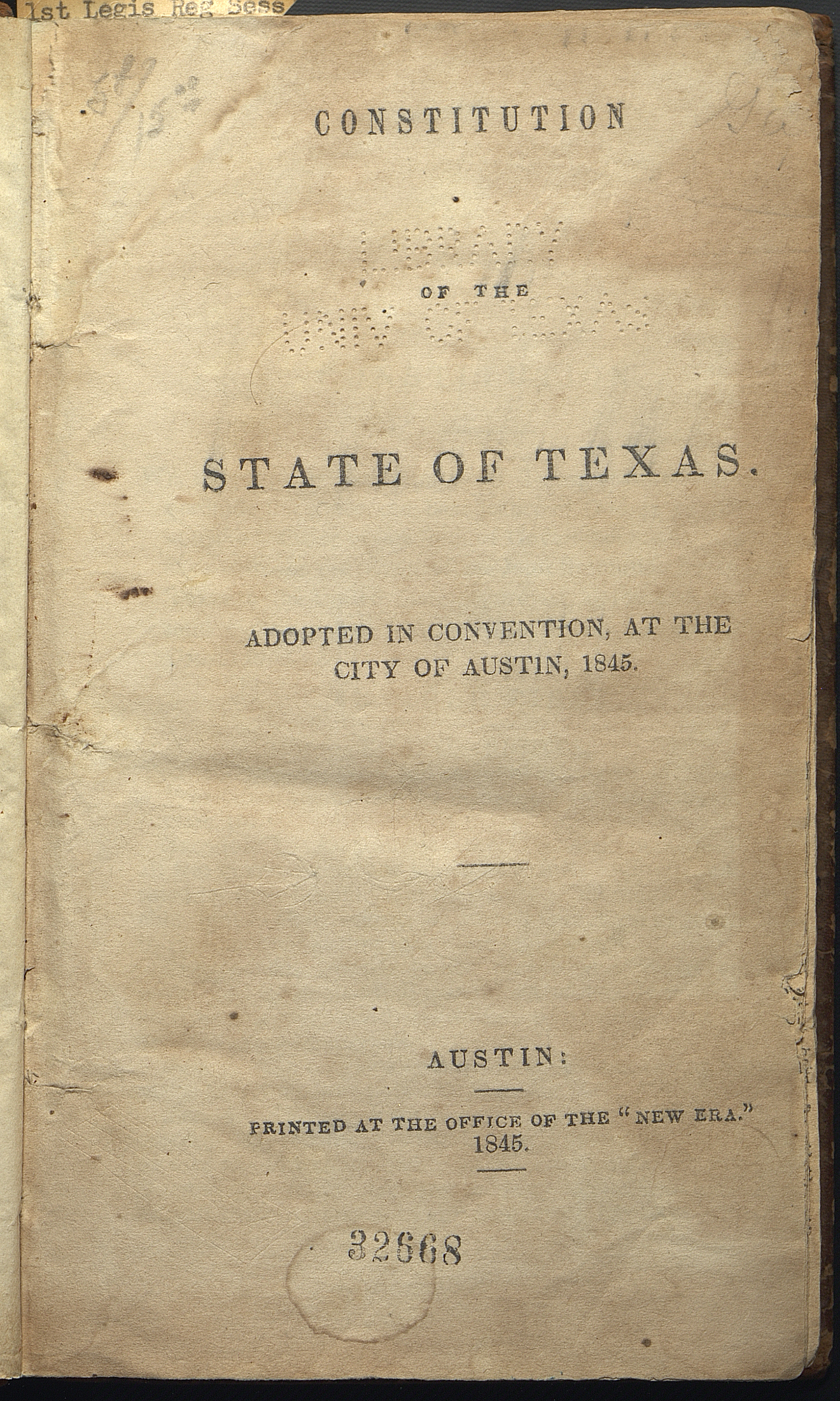 Texas Constitution of 1845" width="400" height="667" />
Texas Constitution of 1845" width="400" height="667" />This section discusses the Constitution of 1845’s role in Texas history.

The Constitution of 1845, which provided for the government of Texas as a state in the United States, was almost twice as long as the Constitution of the Republic of Texas. The framers, members of the Convention of 1845, drew heavily on the newly adopted Constitution of Louisiana and on the constitution drawn by the Convention of 1833 , but apparently used as a working model the Constitution of the republic for a general plan of government and bill of rights.
The legislative department was composed of a Senate of from nineteen to thirty-three members and a House of Representatives from forty- five to ninety. Representatives, elected for two years, were required to have attained the age of twenty-one. Senators were elected for four years, one-half chosen biennially, all at least thirty years old. Legislators’ compensation was set at three dollars a day for each day of attendance and three dollars for each twenty-five miles of travel to and from the capital. All bills for raising revenue had to originate in the House of Representatives. Austin was made the capital until 1850, after which the people were to choose a permanent seat of government. A census was ordered for each eighth year, following which adjustment of the legislative membership was to be made. Regular sessions were biennial. Ministers of the Gospel were ineligible to be legislators.
The governor’s term was two years, and he was made ineligible for more than four years in any period of six years. He was required to be a citizen and a resident of Texas for at least three years before his election and to be at least thirty years of age. He could appoint the attorney general, secretary of state, and supreme and district court judges, subject to confirmation by the Senate; but the comptroller and treasurer were elected biennially by a joint session of the legislature. The governor could convene the legislature and adjourn it in case of disagreement between the two houses and was commander-in-chief of the militia. He could grant pardons and reprieves. His veto could be overruled by two- thirds of both houses.
The judiciary consisted of a Supreme Court, district courts, and such inferior courts as the legislature might establish, the judges of the higher courts being appointed by the governor for six-year terms. The Supreme Court was made up of three judges, any two of whom constituted a quorum. Supreme and district judges could be removed by the governor on address of two-thirds of both houses of the legislature for any cause that was not sufficient ground for impeachment. A district attorney for each district was elected by joint vote of both houses, to serve for two years. County officers were elected for two years by popular vote. The sheriff was not eligible to serve more than four years of any six. Trial by jury was extended to cases in equity as well as in civil and criminal law.
The longest article of the constitution was Article VII, on General Provisions. Most of its thirty-seven sections were limitations on the legislature. One section forbade the holding of office by any citizen who had ever participated in a duel. Bank corporations were prohibited, and the legislature was forbidden to authorize individuals to issue bills, checks, promissory notes, or other paper to circulate as money. The state debt was limited to $100,000, except in case of war, insurrection, or invasion. Equal and uniform taxation was required; income and occupation taxes might be levied; each family was to be allowed an exemption of $250 on household goods. A noteworthy section made exempt from forced sale any family homestead, not to exceed 200 acres of land or city property not exceeding $2,000 in value; the owner, if a married man, could not sell or trade the homestead except with the consent of his wife. Section XIX recognized the separate ownership by married women of all real and personal property owned before marriage or acquired afterwards by gift or inheritance. Texas was a pioneer state in providing for homestead protection and for recognition of community property.
In the article on education the legislature was directed to make suitable provision for support and maintenance of public schools, and 10 percent of the revenue from taxation was set aside as a Permanent School Fund. School lands were not to be sold for twenty years but could be leased, the income from the leases becoming a part of the Available School Fund. Land provisions of the Constitution of 1836 were reaffirmed, and the General Land Office was continued in operation.
By a two-thirds vote of each house an amendment to the constitution could be proposed. If a majority of the voters approved the amendment and two-thirds of both houses of the next legislature ratified it, the measure became a part of the constitution. Only one amendment was ever made to the Constitution of 1845. It was approved on January 16, 1850, and provided for the election of state officials formerly appointed by the governor or by the legislature.
The Constitution of 1845 has been the most popular of all Texas constitutions. Its straightforward, simple form prompted many national politicians, including Daniel Webster, to remark that the Texas constitution was the best of all of the state constitutions. Though some men, including Webster, argued against the annexation of Texas, the constitution was accepted by the United States on December 29, 1845.
More information on the Constitution of Texas (1845) may be found at the Texas Constitutions 1824-1876 project of the Tarlton Law Library, Jamail Center for Legal Research at the University of Texas School of Law, the University of Texas at Austin.
The project includes digitized images and searchable text versions of the constitutions.